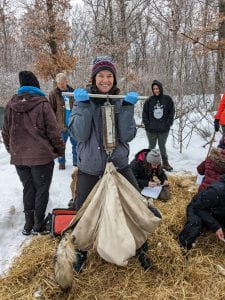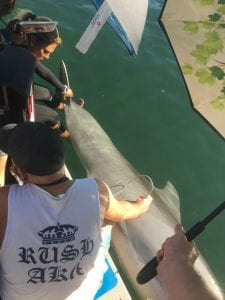
Do you ever wonder about the approach certain wildlife veterinarians took to get to where they are today? Well, I was fortunate enough to chat with Dr. Jennifer Bloodgood over coffee recently to do just that. In November 2022, Dr. Bloodgood was hired as an Assistant Professor of Practice in the Department of Public and Ecosystem Health in the College of Veterinary Medicine, and as a wildlife veterinarian with the Cornell Wildlife Health Lab, part of the New York State Wildlife Health Program. Through these two positions, Dr. Bloodgood essentially gets to work on, “anything and everything wildlife health oriented for the state of New York.” How cool! Since immersing herself in the CVM community almost a year ago, she has had such a positive impact, especially for students who have dreams of following in her footsteps. In writing this post, I hope to convey her inspirational nature as I share about her pathway to becoming a wildlife veterinarian.
Dr. Bloodgood pursued a career in veterinary medicine after obtaining both a Bachelor and Master of Science in Wildlife and Fisheries Biology at Clemson University in South Carolina. After finishing her master’s degree, she worked at the University of Georgia as a research technician where she got to study both harmful algae management and the disease of Avian Vacuolar Myelinopathy. Following her interests in wildlife health and disease, Dr. Bloodgood also worked in the Aquatic Epidemiology Lab at North Carolina State University where she studied endangered freshwater mussel species. Through this job, she not only got to snorkel in local creeks, but she also learned how to manage and propagate endangered species. Dr. Bloodgood then got recruited to work as a veterinary assistant at the North Carolina Museum of Natural Sciences where she assisted in the medical management, health care, and husbandry of hundreds of collection animals. While at the museum, she also developed and delivered education programs for undergraduate students, interns, and volunteers. It was here that Dr. Bloodgood realized how much she loves veterinary medicine, and that she really enjoys educating.
Following her new-found passion, Dr. Bloodgood attended the University of Georgia for 7 years to complete a dual DVM-PhD degree. She finished her PhD during her first semester of vet school, which was completed in Integrative Conservation, a program focused on integrating natural and social sciences with conservation. For her dissertation, Dr. Bloodgood evaluated the nutritional status of rehabilitated green sea turtles at the Georgia Sea Turtle Center and compared it to that of a wild population in Florida. Through this research, she found that feeding squid and fish to captive green sea turtles, as opposed to a vegetarian diet, was associated with obesity and fatty liver disease, as well as high cholesterol and an inverted calcium/phosphorus ratio. She concluded that feeding a vegetarian diet to rehabbed green sea turtles is better for their health than feeding them seafood, which she terms, “the mac and cheese of sea turtles.”

Once Dr. Bloodgood graduated from the University of Georgia, she got to combine her passion for research and aquatic veterinary medicine by securing a job as a research veterinarian at Dauphin Island Sea Lab (DISL) in Alabama (the same place I did my first dolphin necropsy)! Here, Dr. Bloodgood served as a network veterinarian involved in live animal response and necropsy of cetaceans and manatees with the Alabama Marine Mammal Stranding Network and Manatee Sighting Network. During her time at DISL, Dr. Bloodgood worked with the ALMMSN team to study the effects of freshwater on bottlenose dolphins that entered Mobile Bay, a nearby estuary. They discovered that it was a less than ideal environment for them, often inciting skin lesions, and even death. The team also studied the effects of cold stress on manatees in response to climate change. In their natural behavior, manatees should migrate from Alabama to Florida during cold months, but due to increasing temperatures, they are sticking around longer than they should, which has sadly increased their morbidity and mortality. Despite there being a lot of necropsy and pathology involved in her first job, it is the veterinary work that she is most proud of. At DISL, she developed her skills as both a veterinarian and scientist and got to work with some of the world’s most magnificent marine mammals, including a sperm whale, which to her was a life-changing experience.
In fact, Dr. Bloodgood was not even looking to change jobs, but when she saw that Cornell University was hiring, she thought, “it was me in a job description.” She really appreciated all the time she got to spend working with marine mammals, but she was excited for an opportunity to once again practice as a generalist by working with birds, reptiles, and mammals, in addition to marine mammals. She was also really excited about the education aspect of the job, afterall she loves teaching students who share her drive to facilitate conservation and disease management through the lens of veterinary medicine.

Dr. Bloodgood enjoys working in interdisciplinary teams to tackle real-world issues, and she believes her current pos ition allows her to do just that. Even though I only met with Dr. Bloodgood for a brief period, I could tell that she is a perfect fit for the roles she has acquired within the CVM and the New York State Wildlife Health Program. Her passion for wildlife and conservation is contagious, and her journey towards becoming a wildlife veterinarian is certainly inspiring.
In parting ways, I asked Dr. Bloodgood what advice she has for students interested in pursuing a similar career path, and she said, “don’t be afraid to open the door.” Dr. Bloodgood encourages all her students to network – she stresses the importance of meeting people in the field by attending conferences and seeking externships. And while doing so, she recommends following opportunities that one may have never thought of before. For instance, Dr. Bloodgood started her first job after vet school not knowing a lot about marine mammals, but she was excited to try it, and she believes that her curiosity and open-mindedness is what got her to where she is today – and we are fortunate that that is here with us at the CVM!

Maison Scheuer is the 2022-2023 WildLIFE Blog Editor and a proud member of Cornell ZAWS. Her passions lie at the intersection of veterinary medicine and wildlife conservation. She loves to travel and has spent time in Canada, Thailand, Alabama, Belize, and Honduras where she studied Columbian ground squirrels, elephant conservation, wildlife rehabilitation, and veterinary medicine. Though particularly interested in One Health and international medicine, she has also discovered a love for small animal medicine through her experience working as a veterinary technician at a full-service exotics and small animal private practice.



 Hery Ríos-Guzmán, Class of 2024, obtained his Animal Science/Pre-Vet degree from the University of Puerto Rico – Mayagüez. The island environment in which he grew up influenced his professional interests and put him on the path to aquatic veterinary medicine. He has special interests in conservation medi
Hery Ríos-Guzmán, Class of 2024, obtained his Animal Science/Pre-Vet degree from the University of Puerto Rico – Mayagüez. The island environment in which he grew up influenced his professional interests and put him on the path to aquatic veterinary medicine. He has special interests in conservation medi









